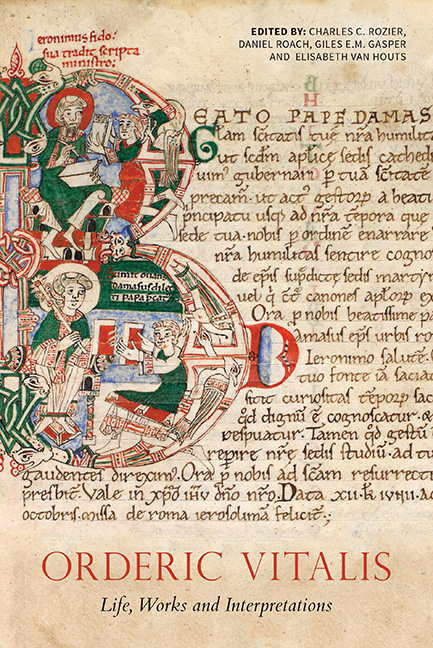Book contents
- Frontmatter
- Dedication
- Contents
- List of Illustrations
- Acknowledgements
- List of Abbreviations
- Chronology of the Lives of Odelerius and his Son Orderic Vitalis
- Composition of the Historia ecclesiastica
- Introduction: Interpreting Orderic Vitalis
- Orderic and his Father, Odelerius
- Following the Master's Lead: The Script of Orderic Vitalis and the Discovery of a New Manuscript (Rouen, BM, 540)
- Orderic Vitalis as Librarian and Cantor of Saint-Évroul
- Saint-Évroul and Southern Italy in Orderic's Historia ecclesiastica
- Orderic and English
- Inscriptions in Orderic's Historia ecclesiastica: A Writing Technique between History and Poetry
- Reading Orderic with Charters in Mind
- Orderic Vitalis and the Cult of Saints
- Orderic's Secular Rulers and Representations of Personality and Power in the Historia ecclesiastica
- Worldly Woe and Heavenly Joy: The Tone of the Historia ecclesiastica
- Orderic Vitalis, Historical Writing and a Theology of Reckoning
- Jesus Christ, a Protagonist of Anglo-Norman History? History and Theology in Orderic Vitalis's Historia ecclesiastica
- ‘Studiosi abdita investigant’: Orderic Vitalis and the Mystical Morals of History
- Meanders, Loops, and Dead Ends: Literary Form and the Common Life in Orderic's Historia ecclesiastica
- Orderic and the Tironensians
- ‘One single letter remained in excess of all his sins …’: Orderic Vitalis and Cultural Memory
- The Reception of Orderic Vitalis in the Later Middle Ages
- Appendix 1 Archaeological Investigations at the Abbey of Saint-Évroult-Notre-Dame-des-Bois
- Appendix 2 Descriptive Catalogue of Manuscripts Featuring the Hand of Orderic Vitalis
- Select Bibliography
- List of Manuscripts Cited
- General Index
Orderic and English
Published online by Cambridge University Press: 25 October 2017
- Frontmatter
- Dedication
- Contents
- List of Illustrations
- Acknowledgements
- List of Abbreviations
- Chronology of the Lives of Odelerius and his Son Orderic Vitalis
- Composition of the Historia ecclesiastica
- Introduction: Interpreting Orderic Vitalis
- Orderic and his Father, Odelerius
- Following the Master's Lead: The Script of Orderic Vitalis and the Discovery of a New Manuscript (Rouen, BM, 540)
- Orderic Vitalis as Librarian and Cantor of Saint-Évroul
- Saint-Évroul and Southern Italy in Orderic's Historia ecclesiastica
- Orderic and English
- Inscriptions in Orderic's Historia ecclesiastica: A Writing Technique between History and Poetry
- Reading Orderic with Charters in Mind
- Orderic Vitalis and the Cult of Saints
- Orderic's Secular Rulers and Representations of Personality and Power in the Historia ecclesiastica
- Worldly Woe and Heavenly Joy: The Tone of the Historia ecclesiastica
- Orderic Vitalis, Historical Writing and a Theology of Reckoning
- Jesus Christ, a Protagonist of Anglo-Norman History? History and Theology in Orderic Vitalis's Historia ecclesiastica
- ‘Studiosi abdita investigant’: Orderic Vitalis and the Mystical Morals of History
- Meanders, Loops, and Dead Ends: Literary Form and the Common Life in Orderic's Historia ecclesiastica
- Orderic and the Tironensians
- ‘One single letter remained in excess of all his sins …’: Orderic Vitalis and Cultural Memory
- The Reception of Orderic Vitalis in the Later Middle Ages
- Appendix 1 Archaeological Investigations at the Abbey of Saint-Évroult-Notre-Dame-des-Bois
- Appendix 2 Descriptive Catalogue of Manuscripts Featuring the Hand of Orderic Vitalis
- Select Bibliography
- List of Manuscripts Cited
- General Index
Summary
Narrating Henry I's attempts to recapture Robert of Bellême in 1102 in Book XI of his Historia, Orderic describes the surrender of Bridgnorth and Henry's subsequent journey with his 60,000 troops north-west to Shrewsbury via the road across Wenlock Edge, widening the cutting as they went. This cutting was a bare ten miles south-east of Orderic's birthplace in Atcham, and it is therefore no surprise that he is well informed about the troops’ movements. It is also no surprise that Orderic knew the English name of this pass – ‘Huvel hegen’ – glossing this as ‘malum callem vel vicum’ (translated by Chibnall as ‘evil path’ or ‘road’). Orderic's inclusion of the English road name raises questions about not only how much knowledge of English he retained in later life, but also his reasons for including this detail in an account of a conflict over English territory between two primarily French-speaking adversaries, written for a Francophone monastic audience within his home monastery of Saint-Évroul.
Chibnall reconstructs the road name given by Orderic as Middle English uvel hege, ‘evil hedge or undergrowth’, but given that Orderic describes it as ‘a deep cutting […] overshadowed on both sides by a thick wood’, it would be preferable to connect the second element with ege, ‘ridge’. There is, moreover, reason to believe that hegen should be construed as a plural, so that the road name should in fact be ‘evil edges’. Orderic's translation of this name is thus doubly wrong: first in that renders hege with callis or vicus, both of which essentially mean ‘road’, thus missing the topographical significance of the name; second, in that he translates as singular a noun that is plural, implying a somewhat shaky recollection of his childhood language. But, as his very inclusion of this phrase suggests, writing in English, and getting it right, seem to have remained important to Orderic. This is apparent from his hypercorrection here. Francophones like Orderic would have been unused to pronouncing [h] at the beginning of words; thus, if they tried to speak English, they would have struggled to pronounce words beginning with [h].
- Type
- Chapter
- Information
- Orderic Vitalis: Life, Works and Interpretations , pp. 100 - 126Publisher: Boydell & BrewerPrint publication year: 2016

